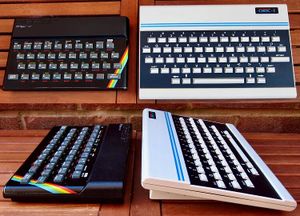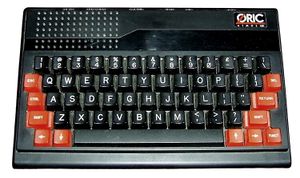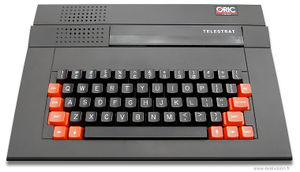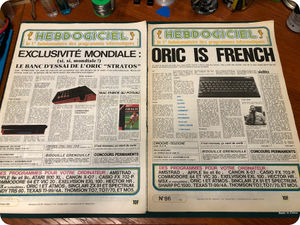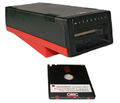Oric-1/Atmos
The Oric-1 and Oric Atmos were 6502-powered competitors to the 48kb ZX Spectrum. The Oric 1 has very much the same form factor, including calculator-style keys, but the Oric Atmos provides a full-travel keyboard.
The Oric was originally one of the competitors for the contract to be the BBC Micro that was ultimately awarded to Acorn.
The Oric machines were not successful in the UK during their commercial lifetime but obtained a dedicated following in France by luck: the Orics were the only machine in their price range to ship with an RGB output socket, which made them the only machine in their price range to be usable with French SECAM televisions, via their SCART(/Péritel) sockets.
Fun fact: The name of the French software house Loriciel is a portmanteau of Oric and logiciel (the french word for software).
In January 1985, it was announced that the grand total number of Oric-1 and Oric Atmos units sold since 1983 was around 350 000. Source
In June 1985, Oric was acquired by Eurêka and became French. The production of the Atmos models was then moved to France, which became the only country manufacturing Oric computers. The British, wanting Oric computers, had to import them! Subsequently, Eurêka revived the former name Oric International and continued the development of their next model, the Telestrat (formerly Stratos).
The Telestrat competed with the Exelvision Exeltel and the Thomson TO9+, other computers designed for France's Minitel network.
Hardware
The Oric used an unusual mixed text/graphics display mode that utilises inline colour attributes.
The Oric's display is 40 bytes across. Each of those bytes may be a control code (to change foreground or background colour, enable or disable graphics mode, etc) or actual content. While in text mode, the content is a character code and the character graphic is looked up indirectly. While in graphics mode, the content is a direct representation of the pixels on that line.
Due to the need to include both control codes and completely-addressable graphics, in graphics mode each byte contains only six pixels ― a seventh bit is used optionally to invert the available colours. So the 40-byte display is at most 240 pixels. In practice it is usually less because of the need to establish foreground and background colours in the leftmost columns.
An AY is provided as the sound chip, exactly as on the CPC, and at same frequency.
The Oric is also notable for shipping initially with a buggy ROM that made loading and saving from tape extremely unreliable. This was corrected in later manufacturing runs.
Clones
The Atmos was licensed in Yugoslavia and sold as Nova 64. The only difference is the logo indicating ORIC NOVA 64 instead of Oric Atmos 48K. This is to indicate the installed 64 KB of RAM – which was also true of the Atmos –, 16 KB of which is masked in both by the ROM at startup, leaving 48 KB to work with the BASIC language.
Yes, a 48K Oric actually has 64K of RAM and yes, you can use it. Source
In Bulgaria, an unlicensed Atmos clone named Pravetz 8D was produced between 1985 and 1991.
Links
- Oric 1 System Review by Nostalgia Nerd
- THE ORIC-1 COMPUTER (story, hardware, BASIC, games and demos) by Olipix Retrotech
- Over 50 Oric games in under 30 minutes
- TV advertisement Oric
- Oric world
- Defence Force wiki Oric wiki
- The Oric Library
- Media:Oric - Service manual.pdf
- Oric 1/Atmos Unofficial ULA Guide
- ULA Decapped!
- 6522 VIA datasheet
- Defence Force Club Europe Oric Forum Oric Oric forums
- Oric International Complete software collection
- JOric Online Oric emulator
